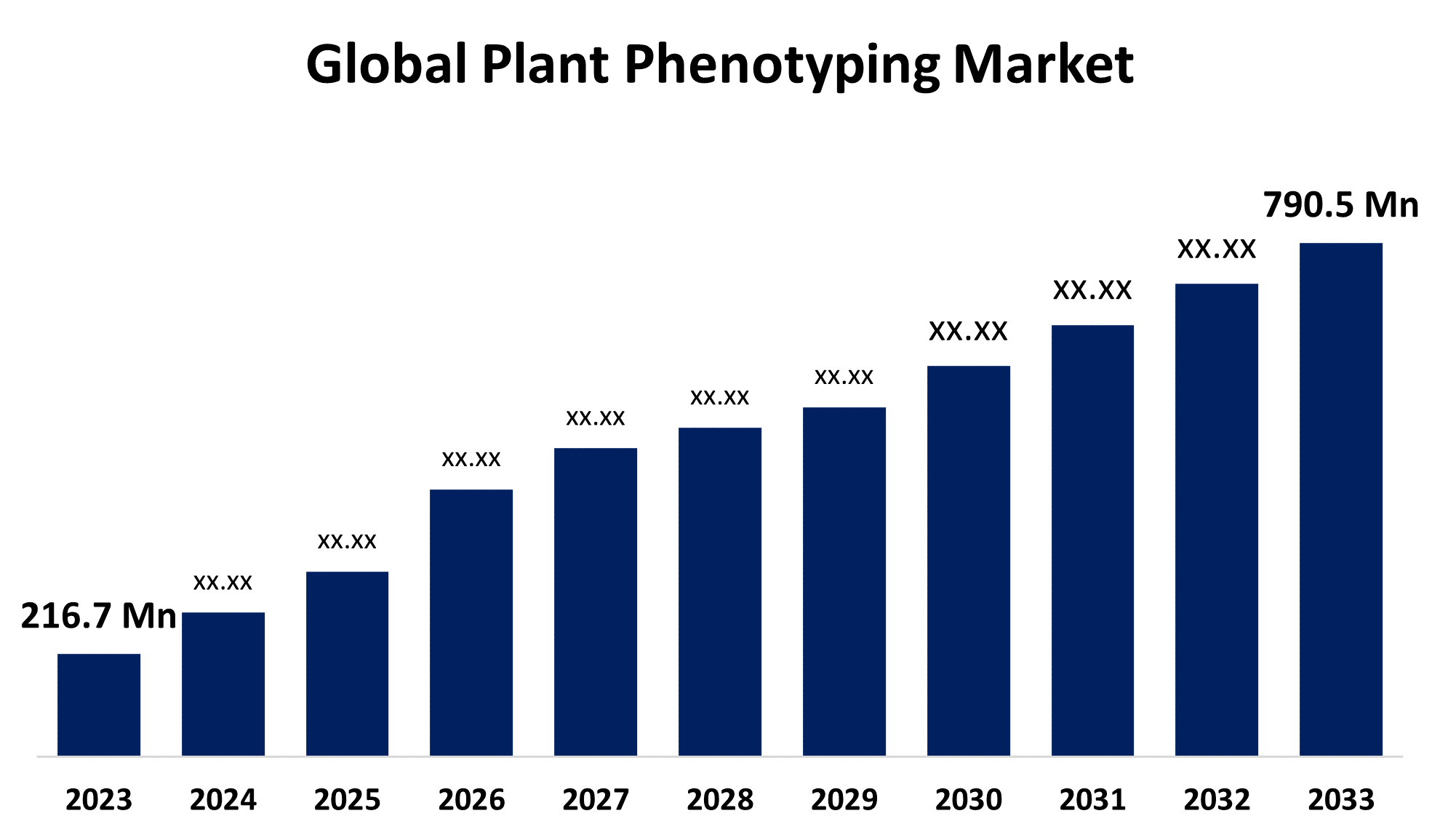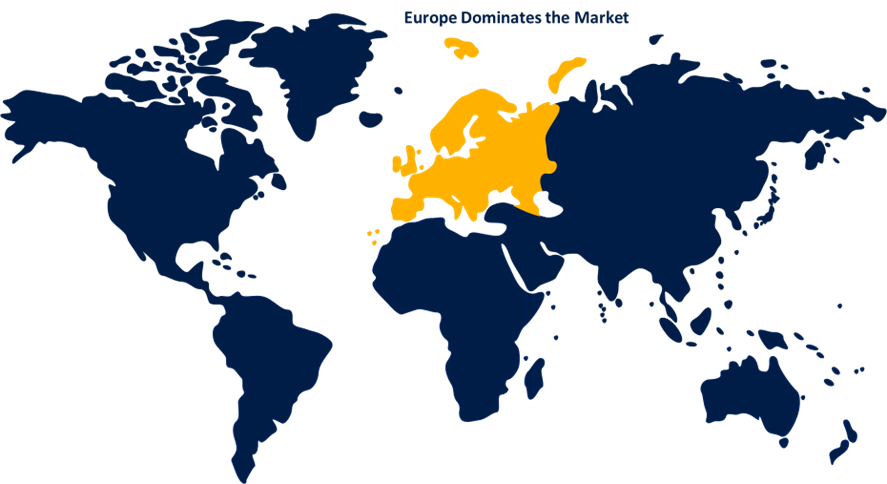Global Plant Phenotyping Market Size, Share, and COVID-19 Impact Analysis, By Product Type (Equipment, Software, Sensors, and Others), By Application (Plant Research, Breeding, Product Development, and Quality Assessment), and By Region (North America, Europe, Asia-Pacific, Latin America, Middle East, and Africa), Analysis and Forecast 2023 - 2033
Industry: AgricultureGlobal Plant Phenotyping Market Insights Forecasts to 2033
- The Global Plant Phenotyping Market Size was Valued at USD 216.7 Million in 2023
- The Market Size is Growing at a CAGR of 11.69% from 2023 to 2033
- The Worldwide Plant Phenotyping Market Size is Expected to Reach USD 790.5 Million by 2033
- North America is Expected to Grow the fastest during the forecast period.

Get more details on this report -
The Global Plant Phenotyping Market Size is Anticipated to Exceed USD 790.5 Million by 2033, Growing at a CAGR of 11.69% from 2023 to 2033.
Market Overview
Plant phenotyping is a systematic examination of a variety of plant characteristics, such as size, shape, and growth patterns, in order to determine how plants react to varied environmental conditions. Plant phenotyping is a set of processes and equipment used to detect plant characteristics and phenotypes including height, color, appearance, behavior, and development. Phenotypes are modified by external or environmental factors apart from their genetic makeup. The understanding and knowledge of plant phenotyping traits leads to increased productivity and assessment of crop quality. Advanced technologies and automated systems are increasingly being utilized to investigate how plants respond to their surroundings. Sensors monitor how the environment affects plants and how they respond. Plant phenotyping has become faster, more precise, and less intrusive because of techniques such as image analysis, canopy studies, and the use of fluorometers. Plant phenotyping is an important tool for crop assessment and breeding, as it detects desirable characteristics in plants, which is used for the development of new varieties of crops which is resistant to pests, environmental stressors, and disease. The increasing use of plant phenotyping for dealing with water stress is one of the most significant factors expected to drive the global plant phenotyping market's growth in the upcoming years.
Report Coverage
This research report categorizes the market for the global plant phenotyping market based on various segments and regions forecasts revenue growth and analyzes trends in each submarket. The report analyses the key growth drivers, opportunities, and challenges influencing the global plant phenotyping market. Recent market developments and competitive strategies such as expansion, product launch, and development, partnership, merger, and acquisition have been included to draw the competitive landscape in the market. The report strategically identifies and profiles the key market players and analyses their core competencies in each sub-segment of the global plant phenotyping market.
Global Plant Phenotyping Market Report Coverage
| Report Coverage | Details |
|---|---|
| Base Year: | 2023 |
| Market Size in 2023 : | USD 216.7 Million |
| Forecast Period: | 2023-2033 |
| Forecast Period CAGR 2023-2033 : | 11.69% |
| 2033 Value Projection: | USD 790.5 Million |
| Historical Data for: | 2019-2022 |
| No. of Pages: | 200 |
| Tables, Charts & Figures: | 110 |
| Segments covered: | By Product Type, By Application, By Region |
| Companies covered:: | BASF SE, Phenospex, Royal Van Zanten, Lemnatec Corporation, Plant-DiTech, Hiphen, BGI Sanya, Phenomix, Keygene, Qubit Systems, OptiSens, Photon Systems Instruments, Vienna Biocenter, Heinz Walz Gmbh, CropDesign, and Others Key Vendors. |
| Pitfalls & Challenges: | COVID-19 Empact, Challenges, Future, Growth, & Analysis |
Get more details on this report -
Driving Factors
The implementation of artificial intelligence (AI) and machine learning (ML) techniques in plant phenotyping has significantly improved the understanding and application of phenotypic data. These innovations facilitate automated and rapid data processing, predictive modeling, and feature extraction. The leading trend in the plant phenotyping market is the ongoing development of precision agriculture and crop monitoring technology. As agriculture becomes more data-driven, the demand for advanced plant phenotyping techniques has increased. These technologies enable farmers and researchers to collect precise and detailed data on plant characteristics, growth patterns, and responses to environmental factors. The rising application of plant phenotyping for dealing with stress caused by water is one of the most important factors anticipated to drive the global plant phenotyping market's growth. The need for high-yielding crops to meet food security requirements has been driven by the growing population, which is increasing the demand for the global plant phenotyping market. The growing population is increasing the need for high-yielding crops to meet food security necessities, which is driving up demand for the worldwide plant phenotyping market.
Restraining Factors
The high initial investment costs imposed by plant phenotyping technologies pose a major barrier to the adoption and application of these advanced techniques, particularly for small-scale research institutions, agricultural organizations, and farmers with limited resources. Rising insufficient technical and conceptual awareness, in addition to rising low adoption in emerging economies due to limited funding and the absence of key players, are among the main obstacles that will limit market growth, while the high expenses of plant phenotyping will further hinder the global plant phenotyping market during the forecast period. The lack of established data formats complicates the integration of data from various phenotyping examinations or tools.
Market Segmentation
The global plant phenotyping market share is classified into product type and application.
- The equipment segment is expected to hold a significant share of the global plant phenotyping market during the forecast period.
Based on the product type, the global plant phenotyping market is divided into equipment, software, sensors, and others. Among these, the equipment segment is expected to hold a significant share of the global plant phenotyping market during the forecast period. Plant breeding companies and researchers frequently utilize imaging tools to phenotype plants, due to technology has become cheaper and more readily available in recent years which is driving the growth of the segment. Imaging technology consists of digital cameras, spectrophotometers, infrared sensors, and laser scanners. This equipment measures a variety of plant properties, including leaf area, biomass, and chlorophyll content.
- The quality assessment segment accounted for the largest revenue share of the global plant phenotyping market during the forecast period.
Based on the application, the global plant phenotyping market is divided into plant research, breeding, product development, and quality assessment. Among these, the quality assessment segment accounted for the largest revenue share of the global plant phenotyping market during the forecast period. Plant phenotyping technology for quality evaluation is intended to measure and analyze features associated with overall plant quality. Remote sensing technologies, including drones outfitted with quality evaluation sensors, are increasingly being used to monitor big agricultural fields and plantations.
Regional Segment Analysis of the Global Plant Phenotyping Market
- North America (U.S., Canada, Mexico)
- Europe (Germany, France, U.K., Italy, Spain, Rest of Europe)
- Asia-Pacific (China, Japan, India, Rest of APAC)
- South America (Brazil and the Rest of South America)
- The Middle East and Africa (UAE, South Africa, Rest of MEA)
Europe is anticipated to hold the largest share of the global plant phenotyping market over the predicted timeframe.

Get more details on this report -
Europe is anticipated to hold the largest share of the global plant phenotyping market over the predicted timeframe. This particular region has a strong market presence, due to widely recognized research institutions and agricultural organizations that promote development. The region's focus on precision agriculture and sustainable farming practices promotes the use of plant phenotyping techniques. The dominance of the European region can be attributed to higher government and other major market players spending on plant phenotyping experiments. A strong commitment to enhancing agricultural research and innovation in the region for agricultural science is seen in the increased spending. Additionally, Europe has a well-established infrastructure for scientific investigation and collaboration, as well as a robust network of research institutions and academic centers specializing in plant biology and agronomy. These factors contribute to Europe's leadership in driving growth and innovation in the plant phenotyping systems market, establishing the area as an important center for technological development and adoption in the industry.
North America is expected to grow at the fastest pace in the global plant phenotyping market during the forecast period. This is attributed to causes such as government and business attempts to develop innovative technologies, as well as the formation of associations dedicated to accelerating plant phenotyping research and development. The global plant phenotyping market is experiencing an increase in demand from a wide range of research organizations. Precision agriculture and the growth of new phenotyping technologies have also helped expand the North America plant phenotyping market.
Competitive Analysis:
The report offers the appropriate analysis of the key organizations/companies involved within the global plant phenotyping market along with a comparative evaluation primarily based on their product offering, business overviews, geographic presence, enterprise strategies, segment market share, and SWOT analysis. The report also provides an elaborative analysis focusing on the current news and developments of the companies, which includes product development, innovations, joint ventures, partnerships, mergers & acquisitions, strategic alliances, and others. This allows for the evaluation of the overall competition within the market.
List of Key Companies
- BASF SE
- Phenospex
- Royal Van Zanten
- Lemnatec Corporation
- Plant-DiTech
- Hiphen
- BGI Sanya
- Phenomix
- Keygene
- Qubit Systems
- OptiSens
- Photon Systems Instruments
- Vienna Biocenter
- Heinz Walz Gmbh
- CropDesign
- Others
Key Target Audience
- Market Players
- Investors
- End-users
- Government Authorities
- Consulting And Research Firm
- Venture capitalists
- Value-Added Resellers (VARs)
Recent Developments
- In November 2022, BGI-Sanya and KeyGene began working together on spatial transcriptomics to quickly identify lead genes related to significant crop attributes.
- In March 2022, A partnership was established between KeyGene and Royal Van Zanten to expedite the breeding of attractive crops. Leading producer of pot plants cut flowers, and flower bulbs, Royal Van Zanten will gain from the collaboration by boosting its team of committed scientists and breeders and expediting the development of market-focused varieties for its ornamental crops.
Market Segment
This study forecasts revenue at global, regional, and country levels from 2020 to 2033. Spherical Insights has segmented the global plant phenotyping market based on the below-mentioned segments:
Global Plant Phenotyping Market, By Type
- Equipment
- Software
- Sensors
- Others
Global Plant Phenotyping Market, By Application
- Plant Research
- Breeding
- Product Development
- Quality Assessment
Global plant phenotyping Market, Regional
- North America
- US
- Canada
- Mexico
- Europe
- Germany
- Uk
- France
- Italy
- Spain
- Russia
- Rest of Europe
- Asia Pacific
- China
- Japan
- India
- South Korea
- Australia
- Rest of Asia Pacific
- South America
- Brazil
- Argentina
- Rest of South America
- Middle East & Africa
- UAE
- Saudi Arabia
- Qatar
- South Africa
- Rest of the Middle East & Africa
Frequently Asked Questions (FAQ)
-
1.Which are the key companies that are currently operating within the market?BASF SE, Phenospex, WIWAM1, Lemnatec Corporation, Plant-DiTech, Hiphen, Delta-T Devices Ltd., Phenomix, Keygene, Qubit Systems, WPS B.V., Photon Systems Instruments, Vienna Biocenter, Heinz Walz Gmbh, and CropDesign.
-
2.What is the size of the global plant phenotyping market?The Global Plant Phenotyping Market Size is Expected to Grow from USD 261.7 Million in 2023 to USD 790.5 Million by 2033, at a CAGR of 11.69% during the forecast period 2023-2033.
-
3.Which region is holding the largest share of the market?Europe is anticipated to hold the largest share of the global plant phenotyping market over the predicted timeframe.
Need help to buy this report?